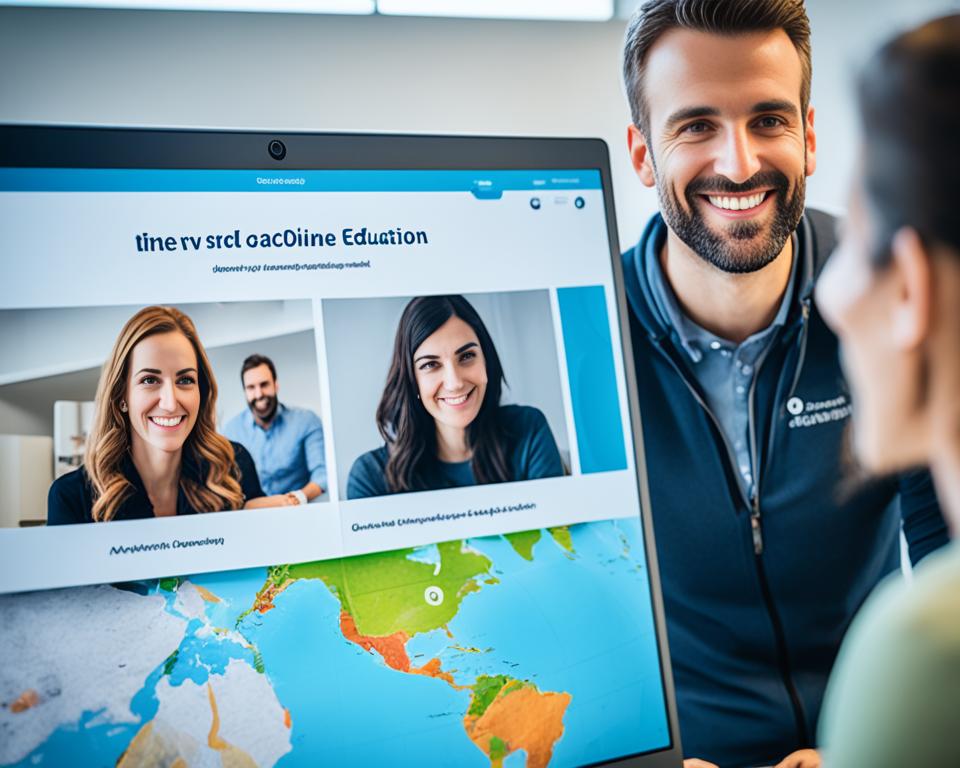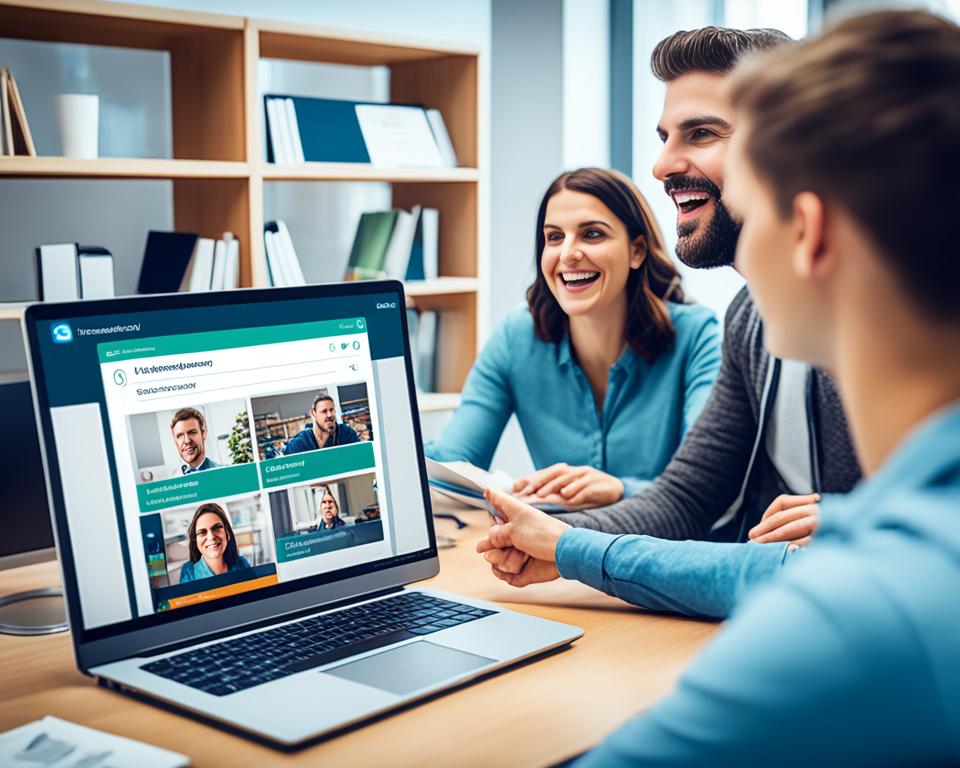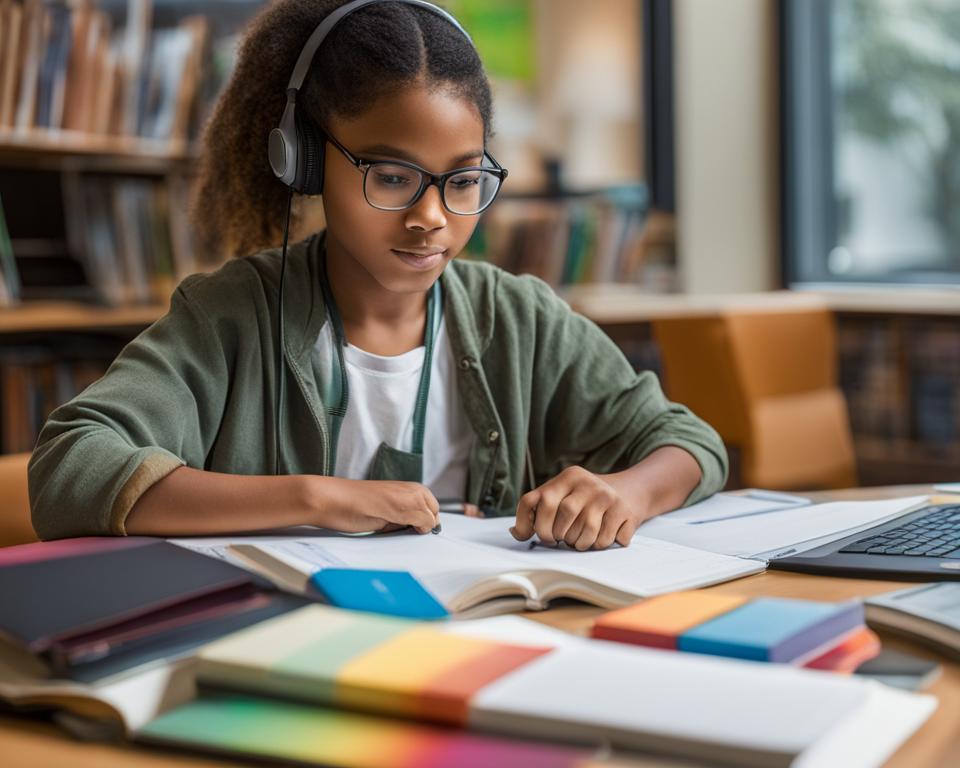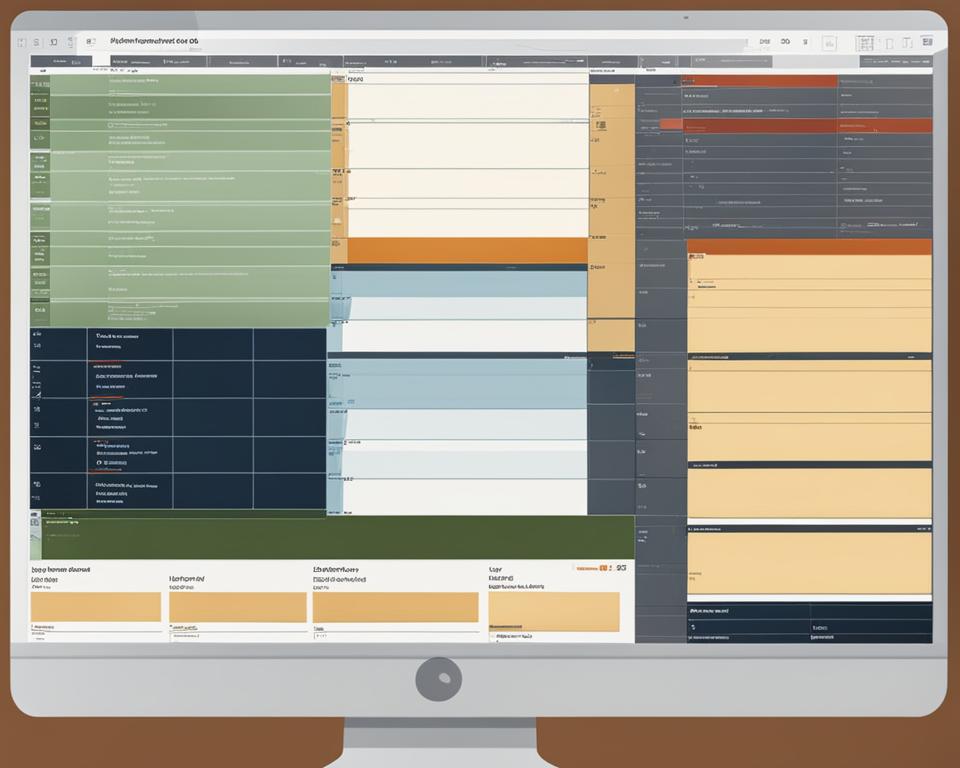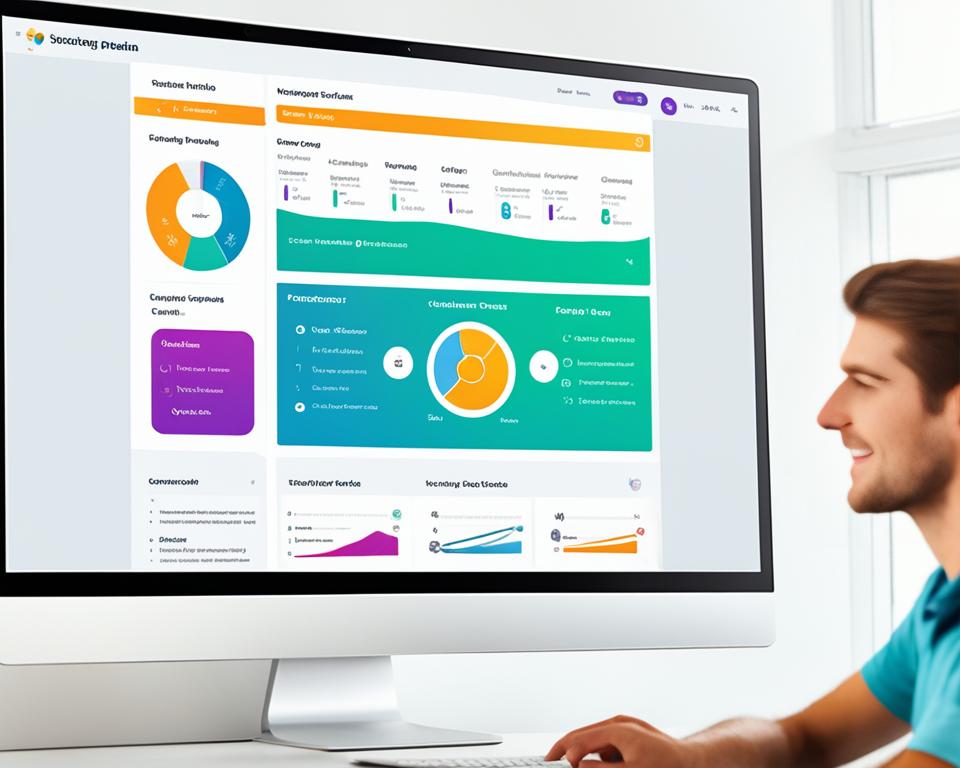Accessibility in higher education is crucial in providing equal access to knowledge and information for individuals with disabilities or different learning needs. In today’s digital age, online learning platforms have emerged as powerful tools for delivering accessible education. From e-learning and virtual classrooms to distance learning and web-based courses, these platforms offer flexible and convenient opportunities for individuals to expand their knowledge and skills.
Key Takeaways:
- Accessible online courses provide equal access to education for individuals with disabilities or different learning needs.
- Online learning platforms offer flexibility and convenience, making education accessible from anywhere.
- E-learning, virtual classrooms, and web-based courses are all part of the digital education revolution.
- Accessible course materials and inclusive design principles ensure all learners can engage with the content.
- Online education fosters flexible learning and enables lifelong learning opportunities.
Understanding Accessibility in Higher Education
Accessibility in higher education is essential in creating an inclusive learning environment that caters to the diverse needs of students. It involves ensuring equal access to educational resources, removing barriers, and providing support for individuals with disabilities or different learning needs.
Digital accessibility plays a significant role in this endeavor. It focuses on designing and developing digital content and services that can be accessed and used by people with disabilities. This includes utilizing assistive technology, providing language support, and offering alternative formats of learning materials.
Assistive technology plays a crucial role in facilitating accessibility in higher education. It assists individuals with disabilities in navigating digital content and materials, enabling them to access information and engage in learning activities effectively. Examples of assistive technology include screen readers, text-to-speech software, and alternative input devices.
Alternative formats of learning materials are also important in ensuring accessibility. These formats cater to different learning preferences and needs, such as providing audio versions of textbooks for students with visual impairments or offering captioned videos for individuals with hearing impairments. By providing alternative formats, institutions promote inclusive learning experiences for all students.
Benefits of Accessibility in Higher Education
An inclusive learning environment that emphasizes accessibility offers several benefits:
- Equal opportunity for all students to access and engage with educational materials
- Enhanced learning experiences through the utilization of assistive technology
- Increased participation and engagement of students with disabilities
- Promotion of diversity, equity, and inclusion in higher education
By prioritizing accessibility, colleges and universities create an environment that values the unique strengths and abilities of every individual, fostering a supportive and inclusive community of learners.
Implementing Accessibility Measures
To ensure accessibility in higher education, institutions can take the following steps:
- Invest in staff training programs to promote awareness of accessibility issues and equip faculty and staff with the necessary knowledge and skills to implement inclusive practices.
- Conduct regular accessibility audits to evaluate the accessibility of digital platforms, websites, and learning materials. This helps identify areas for improvement and ensures ongoing compliance with accessibility standards.
- Collaborate with disability support services to provide individualized accommodations for students with disabilities or different learning needs. This may include extended time for exams, accessible course materials, or assistive technology support.
By implementing these measures, institutions can create an inclusive and accessible environment that benefits all students and promotes their educational success.
Providing Accessibility through eLearning Platforms
eLearning platforms play a crucial role in creating an inclusive learning environment and ensuring equal access to education for all students. These platforms offer a range of accessibility features that promote a barrier-free educational experience. By incorporating these features, eLearning platforms enable students with disabilities or different learning needs to access and engage with course content effectively.
Accessibility features available on eLearning platforms include:
- Alternative text for images: This feature allows students using screen readers to access a description of the visual content, ensuring equal access to visual information.
- Closed captions for videos: Closed captions provide written text for the audio content in videos, benefiting students who are deaf or hard of hearing.
- Compatibility with assistive technology: eLearning platforms are designed to work seamlessly with assistive technologies such as screen readers, voice recognition software, and alternative input devices.
These accessibility features contribute to the creation of an inclusive learning environment, where students with disabilities or different learning needs have equal access to educational resources. Additionally, eLearning platforms offer accommodations that can be tailored to meet the unique requirements of individual students. These accommodations may include extended time for assignments and exams, flexible deadlines, and alternative formats of course materials.
Case Study: Accessibility Features on ABC Learning Platform
The ABC Learning Platform is an example of an eLearning platform that prioritizes accessibility. The platform incorporates various features to ensure equal access for all students. Here is an overview of the accessibility features available on the ABC Learning Platform:
| Accessibility Features | Description |
|---|---|
| Alternative text for images | Every image on the platform includes alternative text, allowing students using screen readers to access a description of the visuals. |
| Closed captions for videos | All videos uploaded on the platform are accompanied by closed captions, enabling students who are deaf or hard of hearing to follow the content. |
| Compatibility with screen readers | The ABC Learning Platform is fully compatible with popular screen readers, ensuring that visually impaired students can access the platform and course materials effortlessly. |
| Flexible deadlines | The platform allows students to request extensions for assignments and quizzes based on their individual needs, providing flexibility and accommodating diverse learning styles. |
Through these accessibility features and accommodations, eLearning platforms like ABC Learning Platform enable an inclusive learning environment where students with disabilities or different learning needs can thrive. By leveraging technology, these platforms contribute to the democratization of education and empower individuals to pursue their academic goals without hindrance.
Creating Accessible Course Content
Creating accessible course content is essential for ensuring that all students can access and engage with the material. Inclusive design principles should be followed to make content usable for everyone. This includes providing alternative formats such as accessible PDFs or large print, ensuring readability through appropriate font sizes and colors, and making content compatible with assistive technology.
Inclusive design is the key to making course content accessible to all students. By implementing inclusive design principles, educators can ensure that their materials are usable and comprehensible to a diverse range of learners.
Alternative formats, such as accessible PDFs or large print, can make course content more accessible for individuals with visual impairments or reading difficulties. These formats provide the flexibility for students to consume information in a way that suits their needs.
Usability and readability are also vital considerations in creating accessible course content. By using appropriate font sizes and colors, educators can enhance the readability of their materials, making it easier for all students to comprehend the content.
Providing Alternative Formats
Offering alternative formats of course materials is a crucial aspect of inclusive design. By providing accessible PDFs, large print versions, or audio transcripts, educators can ensure that students with visual impairments, learning disabilities, or other challenges can access the content effectively.
| Alternative Formats | Benefits |
|---|---|
| Accessible PDFs | Can be read by screen readers and easily navigated |
| Large Print | Allows individuals with visual impairments to read the material comfortably |
| Audio Transcripts | Enables students with hearing impairments to access the content |
By providing alternative formats, educators can cater to the diverse needs of their students, ensuring equal access to course content.
Ensuring compatibility with assistive technology is another crucial aspect of creating accessible course content. By designing materials that can be easily accessed and navigated using assistive devices, educators can enable students with disabilities to fully engage with the content. This may include providing proper headings, using descriptive alt text for images, and ensuring proper structure and organization within documents.
By prioritizing the creation of accessible course content, educators can foster an inclusive learning environment where all students have an equal opportunity to succeed.
Ensuring Accessibility in Teaching and Assessment
When it comes to providing an inclusive learning environment, accessibility should be a top priority in both teaching and assessment methods. Students with disabilities or different learning needs should have equal opportunities to succeed, and accommodations should be made accordingly. Whether it’s through extended time for exams or alternative formats for assignments, these accommodations can help level the playing field and ensure that every student can fully participate in the educational experience.
One approach that can greatly benefit students is the application of universal design for learning (UDL) principles. UDL is a framework that aims to create flexible and inclusive teaching practices that meet the diverse needs of all learners. By incorporating UDL, educators can design and deliver instruction in ways that are accessible, engaging, and meaningful for everyone.
For example, educators can provide multiple means of representation by presenting information in various formats, such as written text, images, and videos, to accommodate different learning styles and preferences. This ensures that students can access the content in a way that works best for them.
Additionally, educators can offer multiple means of engagement to enhance student motivation and participation. This can be achieved by providing options for interactive activities, discussions, and multimedia resources. By offering choices, educators can tap into each student’s unique interests and strengths, creating a more engaging and inclusive learning environment.
Furthermore, educators can incorporate multiple means of expression to allow students to demonstrate their understanding and knowledge in different ways. This can include options for written assignments, oral presentations, group projects, or creative assessments. By providing flexibility in assessment methods, educators can honor the diverse ways in which students can effectively express their learning.
Benefits of Accessibility in Teaching and Assessment
Ensuring accessibility in teaching and assessment not only benefits students with disabilities or different learning needs but also has a positive impact on the learning experience of all students. When learning materials are designed with accessibility in mind, they become more user-friendly and intuitive for everyone.
By applying universal design for learning principles, educators create a learning environment that acknowledges and embraces the unique strengths and challenges of each student. This fosters an inclusive classroom culture, promotes student engagement, and enhances the overall learning outcomes.
Moreover, accessible teaching and assessment practices promote critical thinking and problem-solving skills. When students are given the opportunity to engage with content in various ways and express their understanding through diverse means, they can develop a deeper understanding of the subject matter and apply their knowledge in real-world situations.
Example of Accommodations and Universal Design for Learning Principles in Action
“Providing accommodations and utilizing universal design for learning principles has been transformative in my classroom. I have seen firsthand how students who might have struggled in traditional assessment formats can now showcase their knowledge through alternative means. It has created a more inclusive and dynamic learning environment, benefitting all students.” – Professor Smith
Here’s an example of how accommodations and universal design for learning principles can be applied in a higher education setting:
| Accommodation | Universal Design for Learning Principle |
|---|---|
| Extended time for exams | Multiple means of engagement |
| Alternative formats for assignments (e.g., audio recordings) | Multiple means of representation |
| Flexible assessment options (e.g., written essay or oral presentation) | Multiple means of expression |
By implementing these accommodations and principles, educators can create a learning environment that embraces diverse learning needs and fosters inclusivity. The result is a more engaged and empowered student population, where everyone has an equal opportunity to succeed.
Faculty and Staff Training
Providing faculty and staff with comprehensive accessibility training and ongoing support is crucial for promoting inclusivity in higher education. By equipping educators with the necessary knowledge and tools, they can effectively support students with disabilities or different learning needs and create an inclusive learning environment.
Accessibility training for faculty and staff should cover a range of topics that address the needs of diverse learners. This includes instruction on inclusive teaching practices, disability awareness, and the effective use of assistive technology.
Through accessibility training, faculty and staff gain a deeper understanding of the challenges students with disabilities may face and learn strategies to accommodate their needs. They become familiar with inclusive teaching practices that help ensure all students have equal access to educational resources and opportunities.
By incorporating inclusive teaching practices, faculty and staff can create an environment that embraces diversity and fosters the success of all students. Inclusive teaching practices go beyond accommodating students with disabilities; they benefit all learners by promoting engagement, collaboration, and critical thinking.
Training faculty and staff in inclusive teaching practices empowers them to create an educational experience that is welcoming, accessible, and supportive for students with disabilities or different learning needs.
Disability Awareness and Inclusive Teaching
Disability awareness training is an essential component of faculty and staff training programs. It raises awareness about the different types of disabilities, their impact on learning, and the importance of creating an inclusive and supportive environment.
Through disability awareness training, educators gain a better understanding of the barriers students with disabilities may encounter. This knowledge helps them develop empathy and adapt their teaching practices to ensure equal opportunities for all students.
Inclusive teaching practices focus on designing and delivering instruction that meets the diverse needs of students. This involves creating accessible course materials, using inclusive language and examples, and providing multiple ways for students to demonstrate their understanding.
| Benefits of Inclusive Teaching | Strategies for Implementation |
|---|---|
|
|
By implementing inclusive teaching strategies, educators foster an environment where all students can thrive and achieve their full potential.
Effective faculty and staff support systems complement accessibility training by providing ongoing assistance and resources. This support ensures that educators feel confident and empowered to address accessibility concerns and meet the needs of students with disabilities.
Faculty and staff support systems may include:
- Access to expert advisors or disability services offices
- Online forums and communities for sharing best practices
- Regular professional development opportunities
- Collaborative spaces for discussing accessibility challenges and solutions
By fostering a culture of inclusivity and providing faculty and staff with the necessary training and support, colleges and universities can create an educational environment where all students have equal access to learning opportunities.
Evaluating and Improving Accessibility
Regular evaluation is crucial in ensuring continuous improvement of accessibility in higher education. By conducting accessibility evaluations, institutions can identify areas that require modifications and enhancements. These evaluations involve comprehensive accessibility audits that assess websites, course materials, and other digital content for accessibility compliance.
One effective method of evaluating accessibility is through student feedback. By actively seeking input from students, institutions can gain valuable insights into their experiences with accessibility and identify any issues they may encounter. Student feedback plays a key role in understanding the effectiveness of accessibility measures and enables institutions to make informed decisions regarding improvements.
To further enhance accessibility, continuous improvement efforts should be implemented. This involves addressing the findings from accessibility audits and student feedback and implementing necessary changes. By embracing a culture of ongoing improvement, institutions can ensure that accessibility remains a top priority and that students with disabilities or different learning needs are provided with equal opportunities to access and engage with educational resources.
Accessibility Evaluation Methods
Accessibility evaluations in higher education utilize a variety of methods to assess the level of accessibility in different areas. These methods include:
- Reviewing websites and digital content for compliance with accessibility standards.
- Conducting usability tests with individuals with disabilities to identify any barriers to accessibility.
- Assessing the accessibility of course materials, such as PDFs, videos, and interactive content.
Student Feedback and Its Impact
Student feedback plays a crucial role in improving accessibility in higher education. By actively gathering feedback from students, institutions can:
- Identify specific accessibility challenges that students face.
- Understand the impact of existing accessibility measures on student experiences.
- Address any accessibility issues promptly and effectively.
By involving students in the accessibility evaluation process, institutions can create a more inclusive learning environment that meets the diverse needs of all learners.
Continuous improvement is the key to ensuring that accessibility remains a priority in higher education. It involves an ongoing cycle of evaluation, feedback, and implementation of necessary changes to enhance accessibility in all aspects of education. By continuously striving to improve accessibility, institutions can provide an inclusive educational experience for all students.
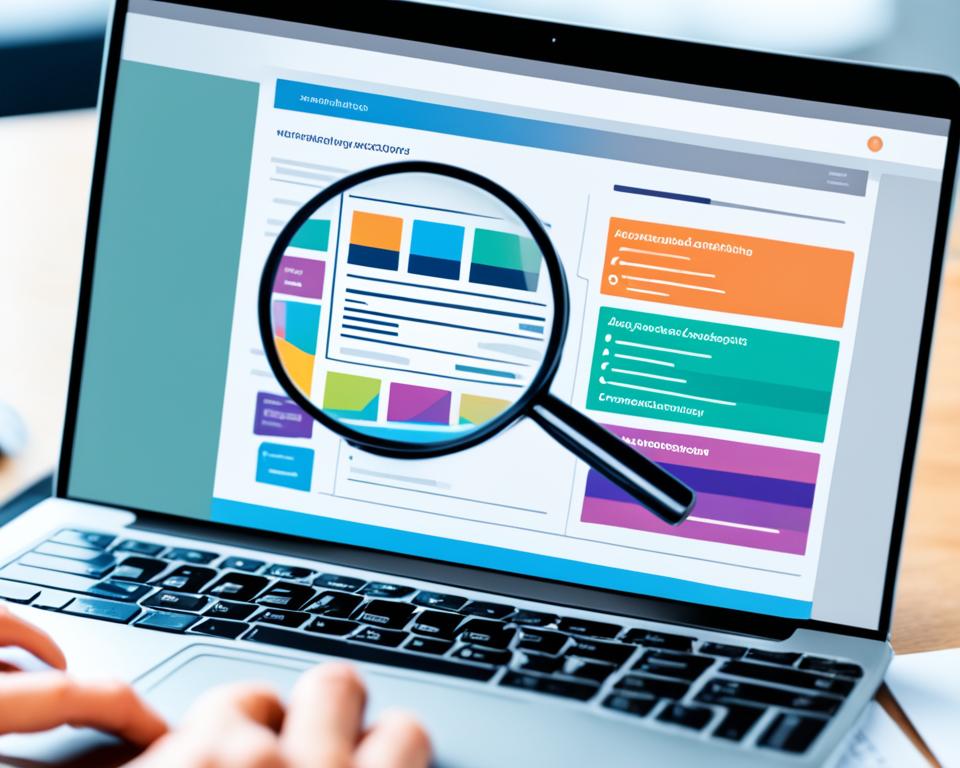
The Benefits of Continuous Improvement
Continuous improvement efforts in accessibility bring several benefits to higher education institutions:
- Enhanced accessibility for students with disabilities or different learning needs.
- Improved user experience for all students, regardless of their abilities.
- Compliance with accessibility laws and regulations.
- A positive reputation for inclusivity and commitment to accessibility.
By prioritizing continuous improvement, institutions foster a culture of accessibility that supports the success and well-being of all students.
Addressing Accessibility in Higher Education Globally
Governments around the world are actively working to ensure accessibility in higher education through the implementation of laws and regulations. These measures are aimed at providing equal access to education for individuals with disabilities or different learning needs. International conventions, such as the United Nations Convention on the Rights of Persons with Disabilities, have also recognized the importance of accessibility in higher education and the right of every individual to access education.
One key aspect of promoting accessibility globally is the development and implementation of inclusive policies. These policies aim to create an inclusive learning environment that accommodates the diverse needs of all students. By embracing inclusive policies, educational institutions can foster equal opportunities for success and ensure that individuals with disabilities can fully participate in higher education.
“Accessibility in higher education is a global concern, and governments and institutions must work together to break down barriers and provide equal access to education for all.”
| Government Regulations | International Conventions | Inclusive Policies |
|---|---|---|
| Enactment of laws and regulations to ensure accessibility in higher education | Recognition of the right to access education for individuals with disabilities | Creation of inclusive learning environments through policies and initiatives |
| Promotion of equal opportunities for students with disabilities | Support for accessibility in higher education globally | Accommodation of diverse learning needs |
| Compliance with accessibility standards | Advocacy for inclusive education | Promotion of equal access to education for all |
By addressing accessibility in higher education globally, we can ensure that individuals with disabilities or different learning needs have the same opportunities as their peers. Collaboration between governments, educational institutions, and international organizations is essential for creating a more inclusive and accessible higher education landscape.
Overcoming Accessibility Barriers
Accessibility barriers in higher education can hinder the full participation of students with disabilities or different learning needs. These barriers come in various forms, including physical, technological, communication, attitude, financial, academic, and transportation barriers. To ensure an inclusive learning environment, colleges and universities must actively work to address and overcome these barriers.
Physical Barriers
Physical barriers refer to obstacles that restrict or impede the physical access and mobility of students with disabilities. Examples include inaccessible buildings, classrooms, and facilities, as well as inadequate ramps or elevators for individuals with mobility impairments.
Technological Barriers
Technological barriers exist when digital platforms, websites, or educational tools lack accessibility features that enable students with disabilities to fully engage in online learning. This includes issues with compatibility with assistive technologies, the absence of closed captions or alternative text for multimedia content, and the inaccessibility of online resources.
Communication Barriers
Communication barriers arise when communication channels, methods, or materials are not accessible to individuals with disabilities. This can include the lack of sign language interpretation, the absence of captioning for live lectures, or the inaccessibility of written materials for students with visual impairments.
Attitude Barriers
Attitude barriers refer to negative attitudes, stereotypes, or misconceptions towards individuals with disabilities. Such barriers can lead to discrimination, exclusion, or the underestimation of the capabilities and potential of students with disabilities in academic settings.
Financial Barriers
Financial barriers limit the access of students with disabilities to higher education due to the additional costs associated with obtaining necessary accommodations or assistive technology. These barriers can create inequalities and hinder equal opportunities for students with disabilities.
Academic Barriers
Academic barriers encompass obstacles that impede students with disabilities from fully participating in the academic environment. This can include inaccessible course materials, lack of accommodations in examinations or assessments, and inflexible teaching methodologies that do not cater to diverse learning needs.
Transportation Barriers
Transportation barriers arise when students with disabilities face difficulties in accessing educational institutions due to limited or inaccessible transportation options. This can hinder their ability to attend classes, participate in extracurricular activities, and fully engage in the college or university experience.
By recognizing and addressing these accessibility barriers, colleges and universities can create an inclusive learning environment that promotes equal opportunities for all students, regardless of their disabilities or learning needs.

Harnessing Technology for Accessibility
Technology plays a vital role in improving accessibility in higher education. By leveraging technology, institutions can provide equal learning opportunities for students with disabilities or different learning needs. Assistive technology, accessible course materials, and inclusive design principles are key factors in creating an accessible learning environment.
Assistive technology: Assistive technology refers to devices, software, or equipment that assist individuals with disabilities in performing tasks. In the context of higher education, assistive technology can include screen readers, speech recognition software, magnification tools, and alternative keyboard or mouse options. These tools enable students with visual impairments, hearing impairments, or motor disabilities to access educational materials and participate in online learning activities.
Accessible course materials: It is essential for institutions to ensure that all course materials are accessible to students with disabilities. This includes textbooks, readings, online resources, and multimedia content. Accessible course materials can be provided in alternative formats, such as accessible PDFs, electronic braille, or closed captioning for videos. By making course materials accessible, institutions can ensure that all students can fully engage with the content and achieve academic success.
Inclusive design principles: Inclusive design involves creating technology and digital resources that are usable by individuals with diverse abilities and needs. When developing learning platforms, websites, or applications, inclusive design principles should be followed. This includes considering factors such as color contrast, font size, navigation, and compatibility with assistive technology. By incorporating inclusive design, institutions can provide an inclusive and user-friendly learning experience for all students.
Technology empowers students with disabilities, breaking down barriers and enabling them to access educational opportunities. It is crucial for institutions to prioritize technology for accessibility to ensure that all students have equal opportunities for learning and success.
Benefits of Technology for Accessibility
- Enables students with disabilities to access educational resources and participate in online learning activities.
- Provides personalized learning experiences to accommodate different learning needs.
- Promotes independent learning and self-advocacy skills for students with disabilities.
- Fosters inclusive and collaborative learning environments.
- Enhances the overall accessibility and usability of digital learning platforms.
By harnessing technology for accessibility, higher education institutions can create a learning environment that embraces diversity and promotes equal access to education for all students.
Conclusion
Distance education, also known as online learning, has revolutionized the way we learn and has the potential to reshape the future of education. With the advent of modern technology, individuals now have enhanced access to education through online platforms, breaking down barriers of time and location.
One of the key advantages of online learning is its flexibility, allowing learners to tailor their educational experiences to their own pace and schedules. Whether it’s pursuing a degree, learning a new skill, or simply expanding one’s knowledge, online learning offers personalized learning experiences that cater to the individual’s needs and goals.
Furthermore, online learning provides opportunities for global networking, connecting learners from different parts of the world. Through virtual classrooms and collaborative online projects, students can interact, learn from diverse perspectives, and build networks that span across borders.
Distance education also promotes lifelong learning, as individuals can continuously access educational resources, update their skills, and explore new fields of study. With the vast amount of online courses and resources available, the possibilities for personal and professional development are endless.
In conclusion, online learning is not just a temporary solution; it is the future of learning. By embracing distance education, individuals can unlock a world of knowledge, expand their horizons, and pave the way for a lifelong journey of personal growth and success.
FAQ
What is accessibility in higher education?
Accessibility in higher education aims to provide equal access to information and knowledge for individuals with disabilities or different learning needs, creating inclusive learning environments and ensuring accessibility through eLearning platforms.
How do eLearning platforms provide accessibility in higher education?
eLearning platforms offer various accessibility features such as alternative text for images, closed captions for videos, and compatibility with assistive technology. They help create an inclusive learning environment by providing equal access to educational resources and accommodations.
What should be considered when creating accessible course content?
Inclusive design principles should be followed to make content usable for everyone. This includes providing alternative formats such as accessible PDFs, ensuring readability through appropriate font sizes and colors, and making content compatible with assistive technology.
How can accessibility be ensured in teaching and assessment?
Accessibility can be ensured by providing accommodations to students with disabilities or different learning needs, such as extended time for exams or alternative formats for assignments. Universal design for learning principles can be applied to create inclusive teaching and assessment practices.
How can faculty and staff support accessibility in higher education?
Faculty and staff can support accessibility through training on inclusive teaching practices, disability awareness, and the use of assistive technology. By equipping them with the knowledge and tools they need, they can effectively support students with disabilities or different learning needs.
How can accessibility in higher education be evaluated and improved?
Accessibility can be evaluated through accessibility audits of websites, course materials, and other digital content. Student feedback should also be considered. Continuous improvement efforts should be made to enhance accessibility in all aspects of higher education.
What are some common accessibility barriers in higher education?
Common accessibility barriers include physical barriers, technological barriers, communication barriers, attitude barriers, financial barriers, academic barriers, and transportation barriers. Colleges and universities must work to address and overcome these barriers to create an inclusive learning environment.
How can technology improve accessibility in higher education?
Technology plays a vital role in improving accessibility. Assistive technology provides solutions for students with disabilities, and institutions should ensure that all course materials are accessible. Inclusive design principles should be followed to create technology that is usable for all students.
What is distance education and how does it promote accessibility?
Distance education, also known as online learning, offers enhanced access to education, flexible learning options, and personalized learning experiences. It promotes accessibility by providing equal opportunities for individuals to access education, regardless of their location or limitations.

